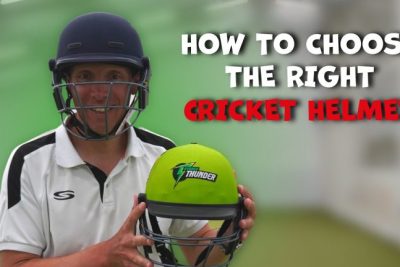Cricket helmets have come a long way over the years, evolving from basic head protection to incorporating a range of innovative features. With player safety being a top priority, modern cricket helmets now boast advanced technologies that provide optimal protection without compromising on comfort. From reinforced carbon fiber shells to strategically placed ventilation systems, these helmets offer a winning combination of durability, breathability, and style. In this article, we delve into the key features that make today’s cricket helmets a must-have for every player, ensuring a worry-free and enjoyable experience on the pitch.
What distinguishes a wicket keeping helmet from a batting helmet?
Cricket wicket keeping helmets and batting helmets might seem similar at first glance, but there are key differences that cater to the specific needs of each position. Wicket keeping helmets are designed to offer maximum protection while being slightly lighter than batting helmets. This ensures that wicket keepers can comfortably wear the helmet for longer periods without feeling excessive strain.
One notable feature of wicket keeping helmets is the cut out in the back of the helmet lid. This design element allows for enhanced comfort, especially during extended periods behind the stumps. By providing a well-ventilated space, wicket keepers can maintain focus and agility without compromising on safety.
While both types of helmets prioritize player safety, batting helmets are generally more focused on head protection against fast bowlers. They are often heavier and have a solid construction to withstand potential impact during aggressive strokes. In contrast, wicket keeping helmets strike a balance between protection and lightweight maneuverability, enabling wicket keepers to swiftly react to the game’s dynamic demands.
In summary, although wicket keeping helmets and batting helmets share a common goal of player safety, their design and features differ. Wicket keeping helmets offer maximum protection with a lighter frame and a cut out in the back for added comfort during prolonged periods behind the stumps. Batting helmets, on the other hand, prioritize head protection against fast bowlers and are typically heavier to withstand hard-hitting shots.
What do wicket keepers wear?
Yes, wicket keepers do wear helmets, especially young ones. It is essential for their safety that they wear a helmet with a faceguard or a wicketkeeper face protector when standing up to the stumps. In order to promote safety and protect young players, schools, cricket clubs, and leagues have made it mandatory for them to wear helmets. This practice has become the norm in cricket throughout England and Wales, ensuring the well-being of young wicket keepers.
The introduction of helmets in cricket has significantly contributed to player safety, particularly for wicket keepers. The use of helmets with faceguards or wicketkeeper face protectors has become a standard practice, especially for young players. This emphasis on safety has been implemented by schools, cricket clubs, and leagues across England and Wales. By wearing helmets, young wicket keepers can minimize the risk of serious injuries and enjoy the game with confidence.
The wearing of helmets is now considered a vital aspect of cricket, especially for wicket keepers. This safety measure is particularly important for young players who are standing up to the stumps. The introduction of helmets with faceguards or wicketkeeper face protectors has been widely supported by schools, cricket clubs, and leagues. This collective effort ensures that young wicket keepers are protected from potential injuries, making the game safer and more enjoyable for everyone involved.
Why is it necessary for a batsman to wear a helmet while playing cricket?
In the game of cricket, wearing a helmet is crucial for the safety of the batsman. Designed specifically to prevent serious injuries caused by being struck on the head by a cricket ball, the cricket helmet is a vital piece of protective gear. Originally developed in response to the increasing speed and aggression of bowlers, batsmen realized the need for protection against fast-pitched deliveries. By donning a helmet, batsmen can confidently face challenging bowling without the fear of a potentially life-threatening blow to the head.
The significance of wearing a cricket helmet cannot be overstated. Its primary purpose is to safeguard batsmen from the risks associated with powerful and unpredictable bowling. As the game evolved and bowlers began to deliver shorter and swifter balls, the need for head protection became increasingly apparent. By embracing the use of helmets, batsmen can focus on their gameplay, knowing that they are shielded from potential head injuries. Thus, the cricket helmet serves as a vital defense mechanism, allowing batsmen to stay safe while engaging in the thrilling and competitive sport of cricket.
Unveiling the Armour: Exploring the Cutting-Edge Features of Cricket Helmets
Cricket helmets have come a long way in providing advanced protection and comfort to players on the field. With cutting-edge features, these helmets offer unparalleled safety without compromising on style. Designed to withstand the impact of fast-paced deliveries, modern cricket helmets incorporate lightweight materials and innovative technologies to protect the head and face from potential injuries.
One of the key features of cricket helmets is their enhanced ventilation system. Traditional helmets often caused discomfort and excessive sweating, affecting the players’ focus and performance. However, with the latest advancements, helmets now feature strategically placed air vents, allowing for better air circulation and temperature regulation. This not only keeps the players cool and comfortable but also reduces the risk of heat-related illnesses during long matches.
Another remarkable feature of cricket helmets is the increased visibility they offer. In the past, players had to compromise on their vision due to bulky designs and obstructed sightlines. However, modern helmets are designed with a focus on maximizing visibility without compromising safety. Clear visors and improved peripheral vision ensure that players have an unobstructed view of the field, enabling quick reactions and better gameplay.
Furthermore, the latest cricket helmets incorporate advanced impact-absorbing materials, such as high-density foam and reinforced carbon fibre. These materials provide superior protection against potential head and facial injuries caused by fast cricket balls. The helmets are also ergonomically designed to fit securely and comfortably on the head, reducing the risk of the helmet shifting or falling off during intense gameplay.
In conclusion, cricket helmets have evolved significantly over the years, incorporating cutting-edge features that prioritize the safety and comfort of players. With enhanced ventilation, improved visibility, and advanced impact protection, these helmets provide a seamless combination of style and functionality. As the game continues to evolve, cricket helmets will undoubtedly continue to push the boundaries of innovation, ensuring that players are well-equipped to face the challenges of the sport.
Safeguarding Your Game: Decoding the Best Cricket Helmet Features for Optimal Protection
Safeguarding Your Game: Decoding the Best Cricket Helmet Features for Optimal Protection
Cricket, a sport that combines skill, strategy, and adrenaline-pumping action, requires players to protect themselves from potential injuries. One crucial piece of equipment that ensures optimal protection is a cricket helmet. Designed to shield the head and face, a high-quality helmet should possess key features that prioritize safety without compromising comfort.
First and foremost, a cricket helmet should have a robust outer shell made from durable materials like ABS plastic or carbon fiber. This ensures that the helmet can withstand the impact of a fast-moving cricket ball. Additionally, it should have a secure chin strap and an adjustable harness system to ensure a snug fit. Proper fitting is essential to prevent the helmet from moving during play, minimizing the risk of head injuries.
Furthermore, an effective cricket helmet should have a strong grille or face guard. The grille should be made of high-quality steel or titanium, providing maximum protection to the face without obstructing the player’s vision. It should also be removable, allowing for easy cleaning and replacement. A well-designed grille will shield the face from potential direct hits, reducing the chances of facial injuries.
Lastly, ventilation is a crucial feature that should not be overlooked. Long hours of play in intense heat can cause discomfort and fatigue. A cricket helmet with strategically placed ventilation holes allows for better airflow, keeping the player cool and focused throughout the game. Additionally, a sweat-absorbent padding lining the interior of the helmet enhances comfort and prevents sweat from dripping into the eyes.
By understanding and decoding the best cricket helmet features, players can make an informed decision when selecting their protective gear. Prioritizing safety, durability, and comfort ensures that players can confidently step onto the field, knowing they are well-protected against potential injuries. Safeguard your game and enjoy cricket to the fullest with the right cricket helmet.
The Definitive Breakdown: Understanding and Selecting the Essential Features in Cricket Helmets
Cricket helmets play a crucial role in safeguarding players from potential head injuries on the cricket field. With an array of options available in the market, understanding and selecting the essential features is paramount. When it comes to cricket helmets, it’s vital to prioritize safety without compromising on comfort and functionality. Look for helmets that provide excellent shock absorption, ensuring optimal protection against fast-paced deliveries. Additionally, helmets with adjustable straps and ventilation systems offer a personalized fit and enhanced breathability, keeping players cool and focused during intense matches. By carefully considering these essential features, cricketers can confidently step onto the pitch, knowing they have the best protection available.
In the game of cricket, where speed and precision collide, selecting the right helmet is of utmost importance. The definitive breakdown of essential features in cricket helmets ensures players can make an informed decision. Opt for helmets with a strong outer shell, designed to withstand powerful impacts and potential head injuries. Inner padding that provides both comfort and protection is another key feature to consider. Additionally, helmets with a faceguard or grille offer added security, shielding the face from wayward balls. By understanding and selecting these essential features, cricketers can enjoy peace of mind, focusing solely on their performance and leaving safety concerns aside.
Power Up Your Defence: Unleashing the Top-notch Features That Make a Cricket Helmet Stand Out
Power Up Your Defence: Unleashing the Top-notch Features That Make a Cricket Helmet Stand Out
When it comes to protecting yourself on the cricket field, a top-notch cricket helmet is an absolute must. Designed with the utmost precision and cutting-edge technology, these helmets are built to withstand even the most powerful of cricket shots. With features like a reinforced steel grille, shock-absorbing padding, and a secure fastening system, these helmets offer unbeatable protection without compromising on comfort. Stay ahead of the game and power up your defence with a cricket helmet that stands out from the rest.
Not all cricket helmets are created equal, but the top-notch features of a quality helmet can make all the difference. Look for helmets that come with advanced ventilation systems to keep you cool and focused during those intense matches. Additionally, helmets with a lightweight design and adjustable straps ensure a snug and secure fit, allowing you to move freely without any distractions. Don’t settle for anything less when it comes to protecting your head on the cricket field. Invest in a cricket helmet that not only meets safety standards but also provides the ultimate in comfort and performance.
Incorporating advanced technology and ergonomic design, today’s cricket helmets offer a seamless blend of protection and comfort. From high-impact resistant materials to strategically placed ventilation, these helmets prioritize the safety and well-being of players without compromising on performance. With customizable fit systems and enhanced visibility, cricket helmets have evolved to meet the demands of modern-day cricket, ensuring that players can focus on their game with the utmost confidence. So, whether it’s a fast-paced bowler or a direct hit, these state-of-the-art helmets stand as a testament to the unwavering commitment towards player safety in the sport of cricket.


